Projects
Current Projects
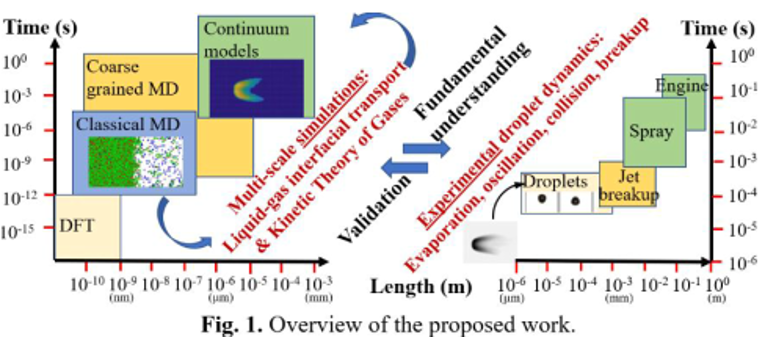
Understanding dynamics and evaporation of microscale liquid fuel droplets in supercritical environments is of great importance to the design and development of advanced propulsion systems such as scramjets, detonation engines, and rocket engines. Droplet dynamics including deformation, collision, breakup, and drag induced acceleration in high-speed flow can critically influence fuel-air mixing with resultant effects on combustor stability, performance, and emissions. In this work, we will use multiscale modeling and dropletscale experiments to study unit phenomena occurring at supercritical and high-speed flow conditions of relevance to fuel injection and mixing processes in advanced propulsion systems.

Gas flows laden with dispersed solid particles are generated in a variety of engineering applications where their interaction with material surfaces can lead to positive or negative outcomes. Examples of the former include spray coatings and cold spray additive manufacturing, while the latter includes surface erosion and deposition affecting the performance of aircraft propulsion systems, wind turbines, and spacecraft in dusty atmospheres. Achieving control of the multiphase interaction process is limited by gaps in fundamental fluid dynamical understanding of momentum and energy transfer processes between the continuous gas phase and dispersed particles, which subsequently drives the interaction outcome between the particles and material surfaces. An integrated research and education program is being pursued to achieve three specific goals: 1) establish a connection between gas phase-influenced particle conditions and collision outcomes when the particles impact a solid surface, 2) use this connection to develop a control scheme to mitigate surface damage utilizing fluidic injection into the boundary layer, and 3) advance aerospace education through implementation of hands-on rocketry and aerodynamics courses for undergraduate and high-school students as well as a traveling exhibit on shockwave propagation aimed at the general public.
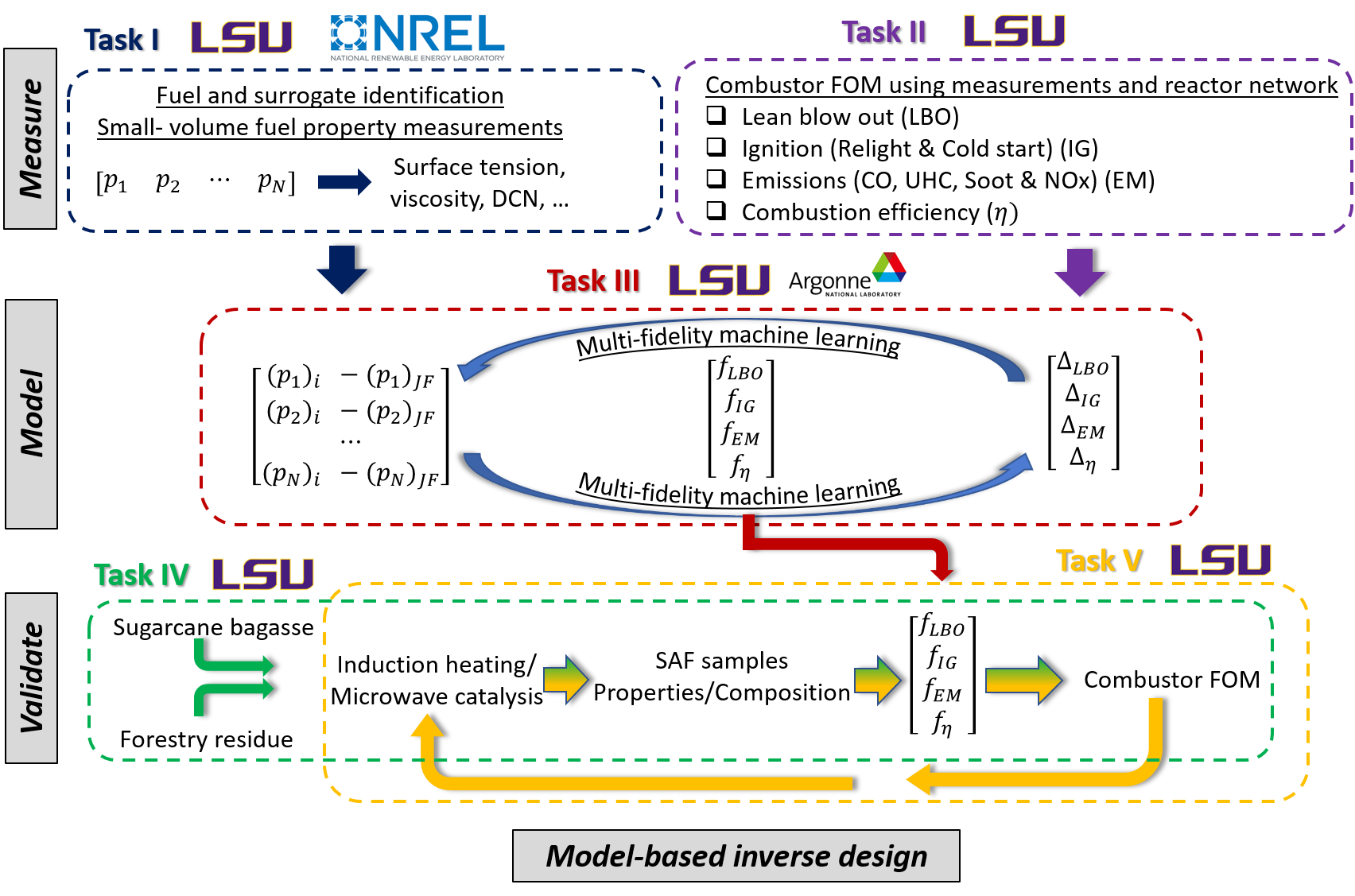
Biomass-derived Sustainable Aviation Fuels (SAF) offer a path to decarbonize emissions, reduce harmful pollution, and impact climate change. Globally, there is a growing effort to adopt SAF for commercial aviation due to sustained growth in aviation demand, lack of short to medium-term technological alternatives, and global competition for finite oil supplies as affected by market volatility and supply-chain issues. A key advantage of SAF is its ability to be synthesized from a large variety of feedstock including agricultural waste and forestry residue. A critical hurdle, however, is the time and expense to ensure candidate fuels, particularly from emerging feedstock, can pass through the ASTM D4054 aviation fuel certification process. This research focuses on the development of an improved pre-screening strategy for candidate SAF, leveraging multi-fidelity machine learning (ML) algorithms to develop functional relationships connecting fuel properties to combustor FOM relevant to aviation engines. The pre-screening strategy developed through this research will incorporate combustor metric sensitivities lacking in current approaches, facilitate model-based tuning of fuel synthesis steps, and pave the way for eventual implementation of engine-fuel co-optimization strategies. The proposed functional relationships representing merit functions for combustor metrics will be established by research tasks conducted by an interdisciplinary team from Louisiana State University (LSU) with critical partnerships to leverage specific expertise, instruments, and modeling capabilities of DOE National Laboratories, including the National Renewable Energy Laboratory (NREL) and Argonne National Laboratory (ANL).
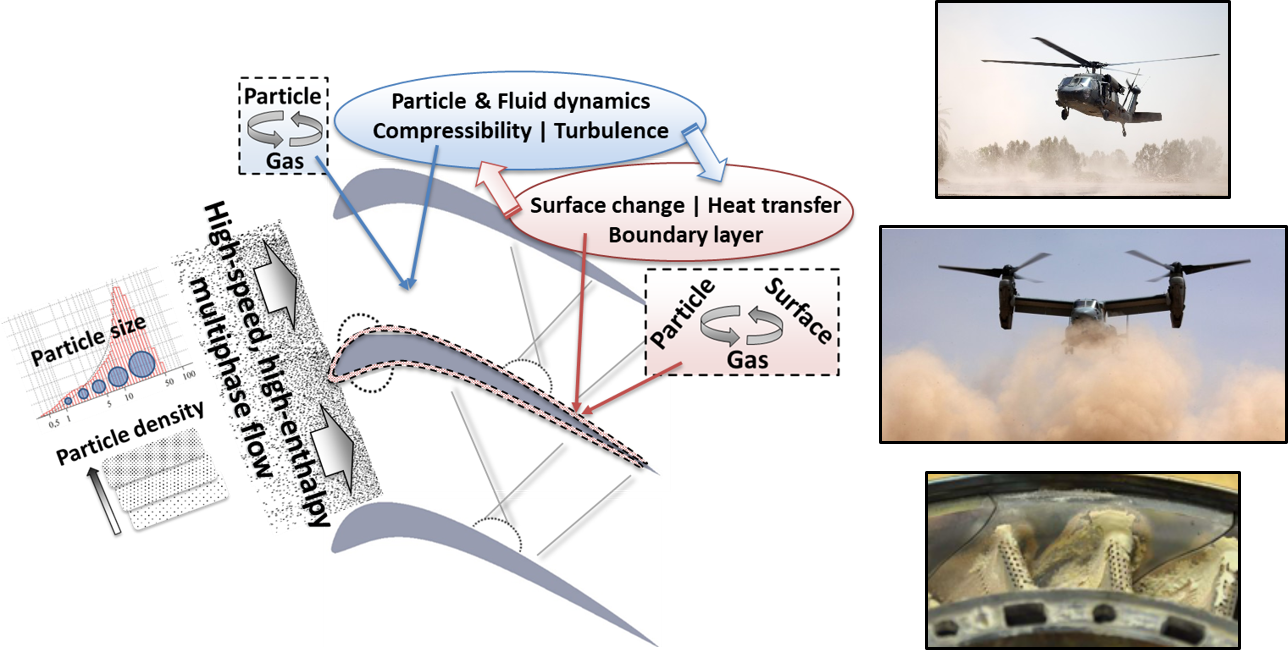
Fluid-structure interaction leading to irreversible material changes is a hallmark of multiphase flows with molten particles dispersed in a gas phase impacting solid surfaces at high-speed, high-enthalpy conditions. Such flows occur frequently in gas turbine engines onboard DoD helicopters and tilt-rotor aircraft operating in sandy and dusty environments. Particle deposition leading to fouling of turbine blades makes engines susceptible to failure and reduces part lifespan resulting in significantly higher maintenance costs. The behavior of multiphase flows over material surfaces involves coupled physical processes, for which, there is a critical lack of understanding, particularly at relevant length- and time-scales in an in-situ manner, as the interactions take place. This is primarily due to extreme operating conditions and associated difficulties with making reliable measurements at those conditions. EPL is working on acquiring fundamental knowledge about the interaction processes using in-situ measurements conducted in a multiphase hot cascade setup. This information will be key for predicting the behavior of such flows and developing approaches to control the flow and its impact on material surfaces.
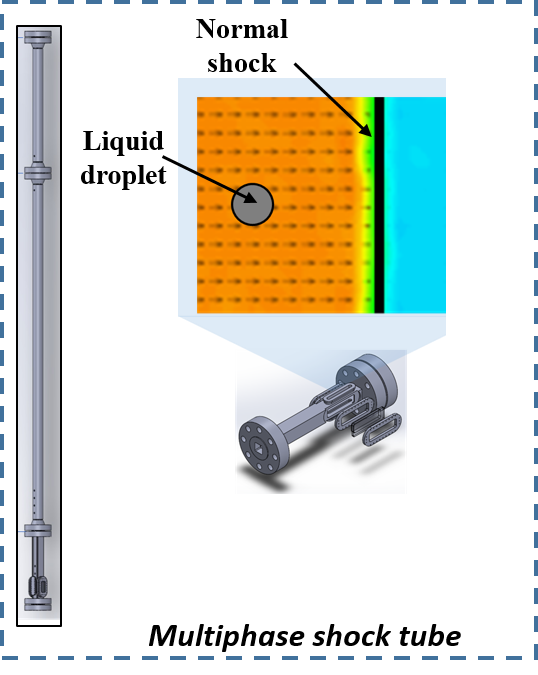 Shock wave induced breakup of fluid droplets occurs in a number of propulsion applications
including rain droplets in high-speed flight and fuel droplets in detonation engines
and rocket nozzles. EPL is conducting controlled experiments using shock tube approaches
to study the underlying phenomena using non-intrusive techniques as well as detailed
numerical simulations.
Shock wave induced breakup of fluid droplets occurs in a number of propulsion applications
including rain droplets in high-speed flight and fuel droplets in detonation engines
and rocket nozzles. EPL is conducting controlled experiments using shock tube approaches
to study the underlying phenomena using non-intrusive techniques as well as detailed
numerical simulations.
- J. Leung*, +, M. Gurunadhan*, S. Menon, “Design and Test of a Shock Tube Facility to Investigate Droplet Aerobreakup”, AIAA Propulsion and Energy Forum, August 24-26, 2020, New Orleans, LA, USA.
- J. Leung*, +, M. Gurunadhan*, S. Menon, “Experimental and computational study of droplet-shockwave interaction for pure fluids and nanofluids”, 2022 Spring Technical Meeting of the Eastern States Section of the Combustion Institute, March 6-9, 2022, Orlando, FL, USA.
- Leung, J.*,+, Gurunadhan, M.*, Menon, S., Single and two-phase fluid droplet breakup in impulsively generated high-speed flow. Under review in Shock Waves.
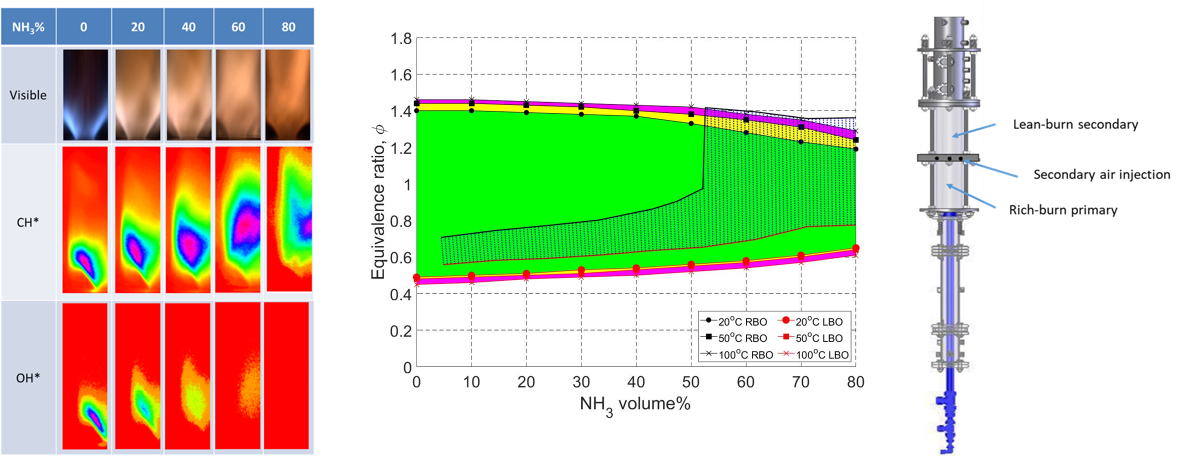
Ammonia holds promise as a zero-carbon fuel with potential to be transported using existing infrastructure and utilized as a fuel in existing power generation devices. EPL is conducting investigations on stability, emissions, and efficiency of Ammonia as a gaseous fuel in swirl combustors. Using experimental and computational approaches we are looking at swirl combustion characteristics of Ammonia supported by the use of novel technologies such as distributed fuel injection using a micro-fuel injection swirler for improved mixing and two-stage combustion for NOx reduction and complete Ammonia consumption.
- V. Viswamithra*, +, S. Menon, “Development of an additively manufactured liquid swirl combustor with ammonia addition for soot reduction”, AIAA Propulsion and Energy Forum, August 24-26, 2020, New Orleans, LA, USA.
- Viswamithra, V. N. R. *, +, Menon, S., A distributed fuel injection approach to suppress lean blow-out and NOx emissions in a methane-ammonia-fueled premixed swirl combustor. ASME Journal of Engineering for Gas Turbines and Power, 2022, Paper No: GTP-21-1631.
- V. Viswamithra*, +, M. Gurunadhan*, S. Menon, “A study on the impact of elevated air temperatures on flame stability and NOx emissions of methane-ammonia-air mixtures in a premixed swirl combustor”, 2022 Spring Technical Meeting of the Eastern States Section of the Combustion Institute, March 6-9, 2022, Orlando, FL, USA.
- Viswamithra, V.*,+, Gurunadhan, M.*, Menon, S., Expanding swirl combustor operability on methane-ammonia-air mixtures using a distributed fuel injection technique and inlet air preheating. Under review in International Journal of Hydrogen Energy.

Temperature measurements in harsh environments such as the exhaust plume of a rocket engine or in the combustion chamber of a hybrid rocket are required for design of spacecraft components and rocket test facilities. EPL is working on implementing a tunable laser diode absorption spectroscopy approach to make non-intrusive temperature measurements. Currently, a water absorption based TDLAS approach implemented on a flat-flame burner is being integrated with a scaled hybrid rocket combustor setup. Gas phase temperature measurements will be used to validate predictions from multiphysics simulations conducted in Fluent.
- C. Becnel*, +, M. Gurunadhan*, S. Menon, “Temperature measurements in the reaction zone of a small scale hybrid rocket combustor using near-infrared tunable diode laser absorption spectroscopy”, 2022 Spring Technical Meeting of the Eastern States Section of the Combustion Institute, March 6-9, 2022, Orlando, FL, USA.
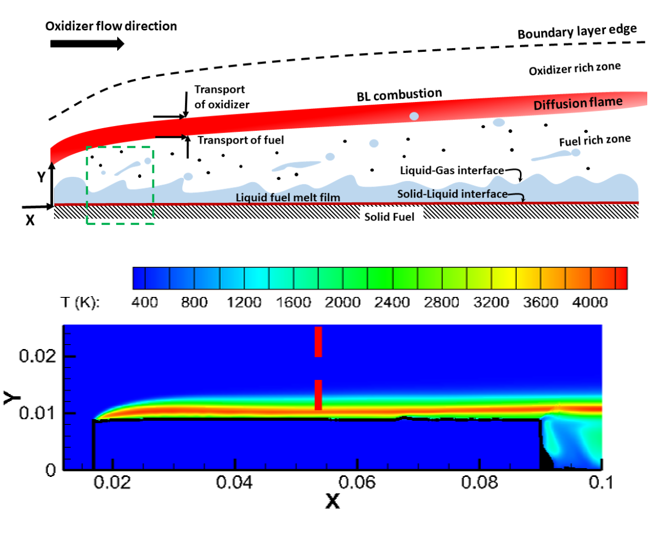 Multiphysics simulations are being conducted to study the detailed fluid dynamic,
gas dynamic, heat transfer, and melting-driven combustion phenomena taking place in
a hybrid rocket combustor.
Multiphysics simulations are being conducted to study the detailed fluid dynamic,
gas dynamic, heat transfer, and melting-driven combustion phenomena taking place in
a hybrid rocket combustor.
- M. Gurunadhan*, S. Menon, A. Baran, “Numerical Simulation of Combustion in a Hybrid Rocket with Liquefying Fuels”, AIAA Propulsion and Energy Forum, August 19-22, 2019, Indianapolis, IN, USA.
- M. Gurunadhan*, +, V. Viswamithra*, K. Gonthier, A. Baran, S. Menon, “A numerical investigation of melt layer effects on hybrid combustion of liquefying fuels”, 2022 Spring Technical Meeting of the Eastern States Section of the Combustion Institute, March 6-9, 2022, Orlando, FL, USA.
Previous Projects

The objective of this work is to investigate hybrid powertrain configurations for propulsion of small unmanned aircraft systems (SUAS). Starting from computational sizing and analysis models to explore static and dynamic performance utilizing measured component data, we plan to identify a hybrid powertrain configuration that provides optimal performance (minimizing energy consumption) for an SUAS mission of relevance to the US Air Force. Next, we plan to build the selected hybrid powertrain and test the integrated setup to measure actual performance and provide data for validating the model predictions. Besides performance data, testing of the integrated hybrid powertrain will be used to investigate noise, vibration, and reliability of the hardware and examine details of its integration with an airframe and development of an appropriate powertrain controller.
- D. Dehesa*, +, S. Menon, “Modeling of Hybrid-Electric Powertrain for Unmanned Aerial Systems”, AIAA Propulsion and Energy Forum, August 19-22, 2019, Indianapolis, IN, USA.
- D. Dehesa*, +, M. Monju*, S. Menon, “Modeling and Testing of Control Logic Approaches for Series Hybrid-Electric Powertrains for Unmanned Aerial Systems”, AIAA Propulsion and Energy Forum, August 24-26, 2020, New Orleans, LA, USA.
- Dehesa, D. *, +, Menon, S., Brown, S., Hagen. C., Dynamic analysis of a series hybrid-electric powertrain for an unmanned aerial vehicle. AIAA Journal of Propulsion and Power, 2022, Vol. 38, 1, 84-96.
- Dehesa Jr, D. A. (2020). Study of Control Schemes for Series Hybrid-Electric Powertrain for Unmanned Aerial Systems, MS thesis, Louisiana State University.

Water spray cooling of the exhaust plume from a rocket is critical in preventing thermal wear of the deflector plate and noise suppression for liquid and solid rocket engines being tested at NASA Stennis Space Center. EPL investigated spray formation dynamics caused by the impingement of a water jet with a supersonic air jet. Various non-intrusive diagnostics such as Focusing Color Schlieren (FCS), Phase Doppler Particle Anemometry (PDPA), and high-speed imaging with laser illumination was used to study spray formation at high gas Weber numbers as well as water jet penetration into the cross-flowing air jet. The setup was further used to study dynamics of droplets entrained into the air jet in a co-flow configuration. Droplet motion as well as change in droplet size driven by coalescence and breakup processes were studied using PDPA and Schlieren techniques experimentally supported by gas flow modeling using Fluent software.
- H. Jones, C. Jeansonne, and S. Menon, "Investigation of Cooling Water Injection into Supersonic Rocket Engine Exhaust", 70th Annual Meeting of the APS Division of Fluid Dynamics, Denver, CO, Nov. 19-21, 2017.
- H. Jones and S. Menon, "Investigation of water jet breakup behavior in crossflow with a supersonic air jet", ICLASS 2018: 14th International conference on liquid atomization & spray systems, July 22-26, 2018, Chicago, USA.
- H. Jones and S. Menon, "Investigation of water jet breakup by supersonic rocket exhaust", AIAA Propulsion and Energy Forum, July 9-11, 2018, Cincinnati, OH, USA.
- H. Jones and S. Menon, "Water jet interaction with supersonic air jet", 71st Annual Meeting of the APS Division of Fluid Dynamics, Atlanta, GA, Nov. 18-20, 2018.
- Jones, H. (2018). Liquid Jet Penetration and Breakup in a Free Supersonic Gas Jet. MS thesis, Louisiana State University.
- Jones, H. *, Menon, S. +, Liquid jet penetration and breakup in a free supersonic gas jet. Experiments in Fluids, 2019, Vol. 60, 161.
- S. Menon+, H. Jones*, J. Leung*, W. Zhao*, “Characterization of spray structures formed during water injection into a free supersonic air jet”, AIAA Propulsion and Energy Forum, August 19-22, 2019, Indianapolis, IN, USA.
- Menon, S.+, Gurunadhan, M. *, Droplet behavior in overexpanded supersonic two-phase jets. International Journal of Multiphase Flow, 2022, Vol. 152, 104076.
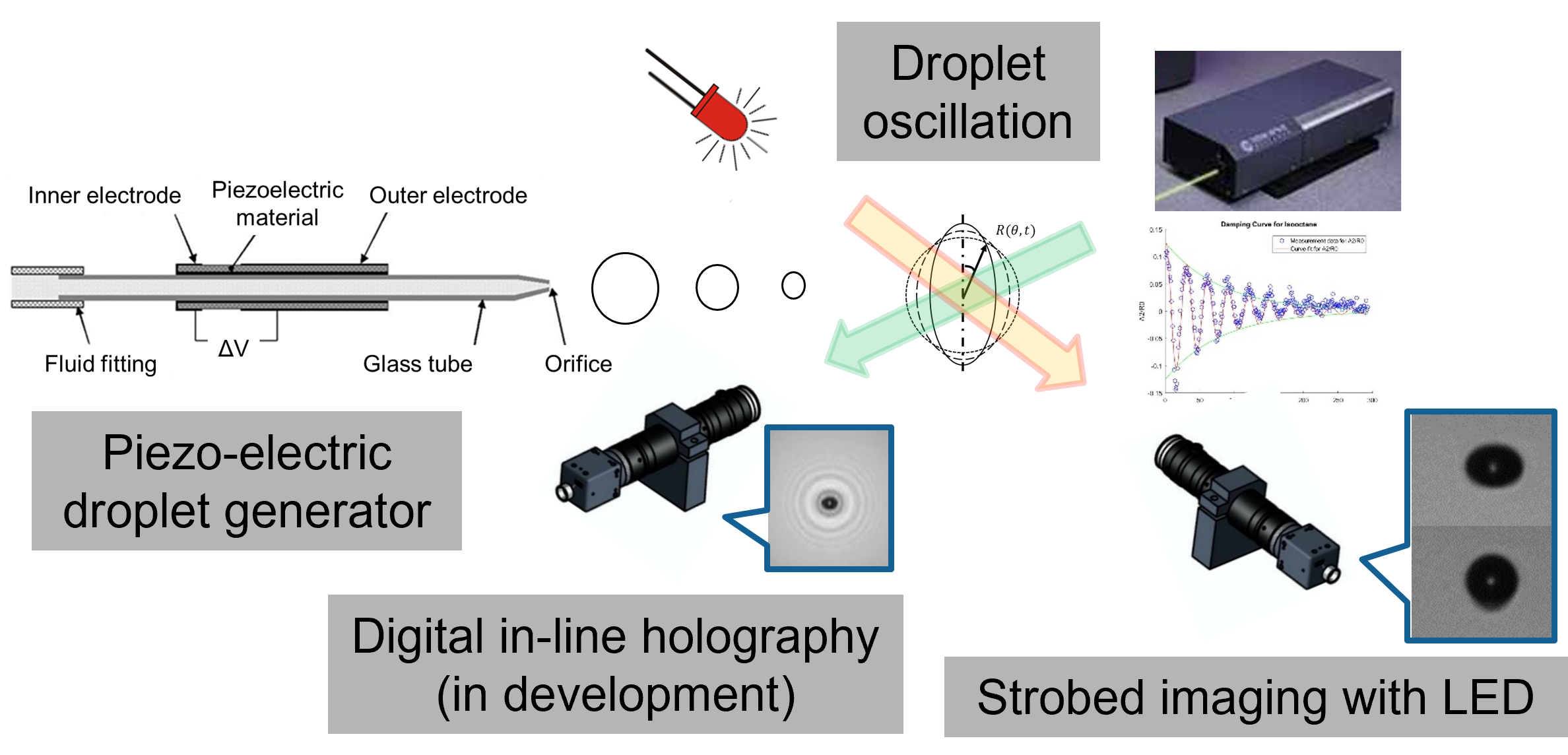 The Department of Energy's Co-optima ( Co-Optimization of Fuels & Engines) program
aims to accelerate engine and fuel development using a simultaneous development approach
which benefits from engineering both pathways to achieve maximum benefits in engine
efficiency and emissions. As part of this program the DOE is interested in developing
novel techniques to ascertain the merits of small quantities of novel bio-fuel which
can be used as drop-in fuels for IC engines or blended with conventional fuels. LSU
with its partners will aid in developing a technique to characterize key fuel physical
and combustion metrics using very small quantities of fuels. The role of the EPL is
to develop a fuel delivery apparatus which will generate a premixed fuel-air mixture
of desired stoichiometry and inlet conditions while utilizing the delivery system
itself to diagnose key liquid fuel properties which play an important role in IC engine
performance.
The Department of Energy's Co-optima ( Co-Optimization of Fuels & Engines) program
aims to accelerate engine and fuel development using a simultaneous development approach
which benefits from engineering both pathways to achieve maximum benefits in engine
efficiency and emissions. As part of this program the DOE is interested in developing
novel techniques to ascertain the merits of small quantities of novel bio-fuel which
can be used as drop-in fuels for IC engines or blended with conventional fuels. LSU
with its partners will aid in developing a technique to characterize key fuel physical
and combustion metrics using very small quantities of fuels. The role of the EPL is
to develop a fuel delivery apparatus which will generate a premixed fuel-air mixture
of desired stoichiometry and inlet conditions while utilizing the delivery system
itself to diagnose key liquid fuel properties which play an important role in IC engine
performance.
- W. Dang, W. Zhao, and S.Menon, "Investigation of a piezoelectric droplet delivery method for fuel injection and physical property evaluation", 70th Annual Meeting of the APS Division of Fluid Dynamics, Denver, CO, Nov. 19-21, 2017.
- W. Dang, W. Zhao, and S.Menon, "Evaporation of single droplets of multicomponent liquid fuel blends at elevated temperatures", ICLASS 2018: 14th International conference on liquid atomization & spray systems, July 22-26, 2018, Chicago, USA.
- W. Dang and S. Menon, "Physical property measurement of primary reference fuels and blends using a droplet generator and high-speed imaging", 71st Annual Meeting of the APS Division of Fluid Dynamics, Atlanta, GA, Nov. 18-20, 2018.
- W. Dang*, +, S. Menon, “Small-volume, High-throughput Techniques for Fuel Physical
Property Measurements”, AIAA Propulsion and Energy Forum, August 19-22, 2019, Indianapolis,
IN, USA.
W. Dang*, +, S. Menon, “Determination of heat of vaporization and vapor pressure by micro-liter fuel droplet vaporization”, AIAA Propulsion and Energy Forum, August 24-26, 2020, New Orleans, LA, USA. - Dang, W. *, +, Zhao, W. *, Schoegl, I., Menon, S., A small-volume, high-throughput approach for surface tension and viscosity measurements of liquid fuels. Measurement Science and Technology, 2020, Vol. 31, 9.
- W. Dang*, I. Schoegl, S. Menon+, “Droplet-based fuel property measurement techniques”, presented at ACS Fall Meeting 2021, August 22-26, 2021, Atlanta, GA, USA.
- Dang, W. *, +, Gurunadhan, M. *, Schoegl, I., Menon, S., Temperature effects on droplet oscillation with application to fuel property measurement. Atomization and Sprays, 2021, Vol. 31, 10.
- Dang, W. *, +, Gurunadhan, M. *, Ard, W. *, Schoegl, I., Menon, S., Droplet evaporation-based approach for microliter fuel property measurements. International Journal of Thermophysics, 2022, Vol. 43, 4, 1-27.
- Dang, W. (2021). Droplet-Based Fuel Property Measurements. PhD thesis, Louisiana State University.